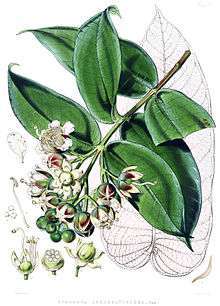Duabanga grandiflora
| Duabanga grandiflora | |
|---|---|
 | |
| Scientific classification | |
| Kingdom: | Plantae |
| (unranked): | Angiosperms |
| (unranked): | Eudicots |
| (unranked): | Rosids |
| Order: | Myrtales |
| Family: | Lythraceae |
| Genus: | Duabanga |
| Species: | D. grandiflora |
| Binomial name | |
| Duabanga grandiflora (Roxb. ex DC.) Walpers | |

From its peculiar habit, Duabanga grandiflora (syn. D. sonneratioides) is a singular feature in its native forests. The trunk is erect, 40–80 feet high, undivided but sometimes forking from the base. The lower limbs spread drooping from the trunk; these are long, slender, sparingly branched, and the branches are four-angled, loosely covered with large spreading leaves. Since the leaves are arranged in two ranks, the slender branches resemble petioles, bearing pinnae of a compound leaf; the leaves are further often recurved, and are deep green above, and almost white beneath. The large blossoms expand in April, exhaling a rank odour reportedly resembling asafoetida when they first burst, but they become inodorous before the petals drop. The stamens are all bent inwards in bud. The fruit is a large as a small apple. The wood is white and soft.[1]
References
- ↑ Hooker p.56
- Hooker, Joseph Dalton; J. F. Cathcart; W. H. Fitch (1855). Illustrations of Himalayan plants. London: L. Reeve. pp. 55–56. LCC QK349.33 .H66 1855.
Gallery
-

trunk at Jayanti in Buxa Tiger Reserve in Jalpaiguri district of West Bengal, India.
-

middle story at Jayanti in Buxa Tiger Reserve in Jalpaiguri district of West Bengal, India.
-

at Jayanti in Buxa Tiger Reserve in Jalpaiguri district of West Bengal, India.
-

leaves at Jayanti in Buxa Tiger Reserve in Jalpaiguri district of West Bengal, India.